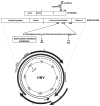Molecular virology of hepatitis B virus for clinicians
- PMID: 17981225
- PMCID: PMC2144742
- DOI: 10.1016/j.cld.2007.08.002
Molecular virology of hepatitis B virus for clinicians
Abstract
This article reviews the molecular biology of the hepatitis B virus in an effort to explain its natural history from a molecular perspective. The life cycle of the virus, with special attention to virus replication, polypeptide production, and morphogenesis, is described. The way in which these steps may influence the natural history of viral pathogenesis, as well as the effectiveness of interventions, receives special consideration.
Figures





References
-
- Ganem D, Prince AM. Hepatitis B infection: natural history and clinical consequences. New England Journal of Medicine. 2004;350:1118–1129. - PubMed
-
- Menne S, Tennant BC. Unraveling hepatitis B virus infection of mice and men (and woodchucks and ducks) Nature Medicine. 1999;5:1125–1126. - PubMed
-
- Hoofnagle JH, di Bisceglie AM. The treatment of chronic viral hepatitis. New England Journal of Medicine. 1997;336:347–356. - PubMed
Publication types
MeSH terms
Substances
Grants and funding
LinkOut - more resources
Full Text Sources
Other Literature Sources

